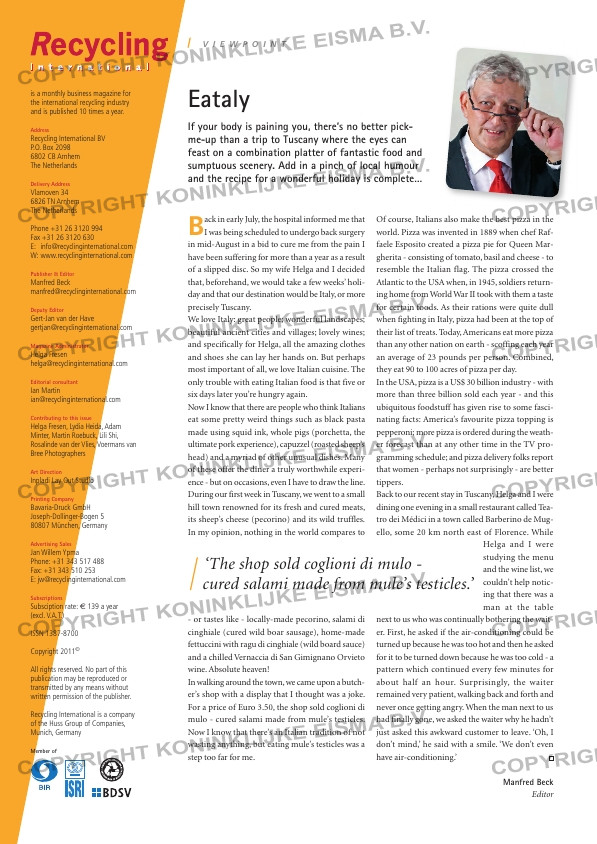Page 3 from: August 2011

V I E W P O I N T
Manfred Beck
Editor
Back in early July, the hospital informed me that I was being scheduled to undergo back surgery
in mid-August in a bid to cure me from the pain I
have been suffering for more than a year as a result
of a slipped disc. So my wife Helga and I decided
that, beforehand, we would take a few weeks’ holi-
day and that our destination would be Italy, or more
precisely Tuscany.
We love Italy: great people; wonderful landscapes;
beautiful ancient cities and villages; lovely wines;
and specifically for Helga, all the amazing clothes
and shoes she can lay her hands on. But perhaps
most important of all, we love Italian cuisine. The
only trouble with eating Italian food is that five or
six days later you’re hungry again.
Now I know that there are people who think Italians
eat some pretty weird things such as black pasta
made using squid ink, whole pigs (porchetta, the
ultimate pork experience), capuzzel (roasted sheep’s
head) and a myriad of other unusual dishes. Many
of these offer the diner a truly worthwhile experi-
ence – but on occasions, even I have to draw the line.
During our first week in Tuscany, we went to a small
hill town renowned for its fresh and cured meats,
its sheep’s cheese (pecorino) and its wild truffles.
In my opinion, nothing in the world compares to
– or tastes like – locally-made pecorino, salami di
cinghiale (cured wild boar sausage), home-made
fettuccini with ragu di cinghiale (wild board sauce)
and a chilled Vernaccia di San Gimignano Orvieto
wine. Absolute heaven!
In walking around the town, we came upon a butch-
er’s shop with a display that I thought was a joke.
For a price of Euro 3.50, the shop sold coglioni di
mulo – cured salami made from mule’s testicles.
Now I know that there’s an Italian tradition of not
wasting anything, but eating mule’s testicles was a
step too far for me.
Of course, Italians also make the best pizza in the
world. Pizza was invented in 1889 when chef Raf-
faele Esposito created a pizza pie for Queen Mar-
gherita – consisting of tomato, basil and cheese – to
resemble the Italian flag. The pizza crossed the
Atlantic to the USA when, in 1945, soldiers return-
ing home from World War II took with them a taste
for certain foods. As their rations were quite dull
when fighting in Italy, pizza had been at the top of
their list of treats. Today, Americans eat more pizza
than any other nation on earth – scoffing each year
an average of 23 pounds per person. Combined,
they eat 90 to 100 acres of pizza per day.
In the USA, pizza is a US$ 30 billion industry – with
more than three billion sold each year – and this
ubiquitous foodstuff has given rise to some fasci-
nating facts: America’s favourite pizza topping is
pepperoni; more pizza is ordered during the weath-
er forecast than at any other time in the TV pro-
gramming schedule; and pizza delivery folks report
that women – perhaps not surprisingly – are better
tippers.
Back to our recent stay in Tuscany, Helga and I were
dining one evening in a small restaurant called Tea-
tro dei Médici in a town called Barberino de Mug-
ello, some 20 km north east of Florence. While
Helga and I were
studying the menu
and the wine list, we
couldn’t help notic-
ing that there was a
man at the table
next to us who was continually bothering the wait-
er. First, he asked if the air-conditioning could be
turned up because he was too hot and then he asked
for it to be turned down because he was too cold – a
pattern which continued every few minutes for
about half an hour. Surprisingly, the waiter
remained very patient, walking back and forth and
never once getting angry. When the man next to us
had finally gone, we asked the waiter why he hadn’t
just asked this awkward customer to leave. ‘Oh, I
don’t mind,’ he said with a smile. ‘We don’t even
have air-conditioning.’
If your body is paining you, there’s no better pick-
me-up than a trip to Tuscany where the eyes can
feast on a combination platter of fantastic food and
sumptuous scenery. Add in a pinch of local humour
and the recipe for a wonderful holiday is complete…
Eatalyis a month ly busi ness mag a zine for the inter na tion al recy cling indus try
and is pub lished 10 times a year.
Address
Recycling International BV
P.O. Box 2098
6802 CB Arnhem
The Netherlands
Delivery Address
Vlamoven 34
6826 TN Arnhem
The Netherlands
Phone +31 26 3120 994
Fax +31 26 3120 630
E: info@recy clin gin ter na tion al.com
W: www.recy clin gin ter na tion al.com
Publisher & Editor
Manfred Beck
[email protected]
Deputy Editor
Gert-Jan van der Have
[email protected]
Magazine Administrator
Helga Fresen
[email protected]
Editorial con sul tant
Ian Martin
[email protected]
Contributing to this issue
Helga Fresen, Lydia Heida, Adam
Minter, Martin Roebuck, Lili Shi,
Rosalinde van der Vlies, Voermans van
Bree Photographers
Art Direction
Inpladi Lay Out Studio
Printing Company
Bavaria-Druck GmbH
Joseph-Dollinger-Bogen 5
80807 München, Germany
Advertising Sales
Jan Willem Ypma
Phone: +31 343 517 488
Fax: +31 343 510 253
E: [email protected]
Subscriptions
Subsciption rate: e 139 a year
(excl. V.A.T.)
ISSN 1387-8700
Copyright 2011©
All rights reserved. No part of this
pub li ca tion may be repro duced or
trans mit ted by any means with out
writ ten per mis sion of the pub lish er.
Recycling International is a company
of the Huss Group of Companies,
Munich, Germany
Member of
‘The shop sold coglioni di mulo –
cured salami made from mule’s testicles.’
p003_Viewpoint.indd 3 10-08-11 09:48



